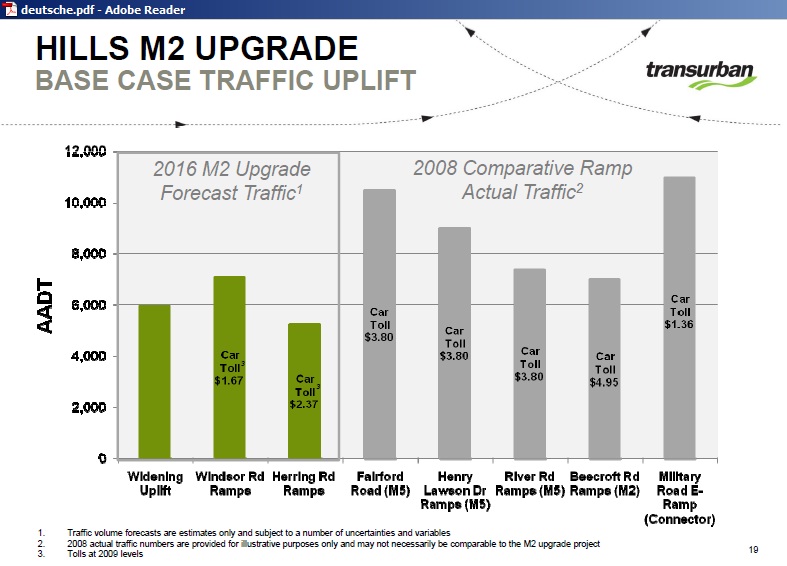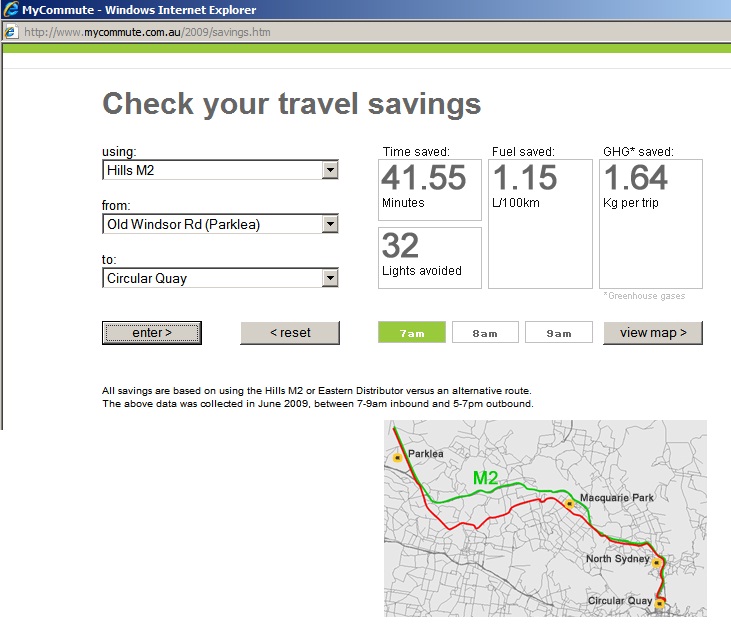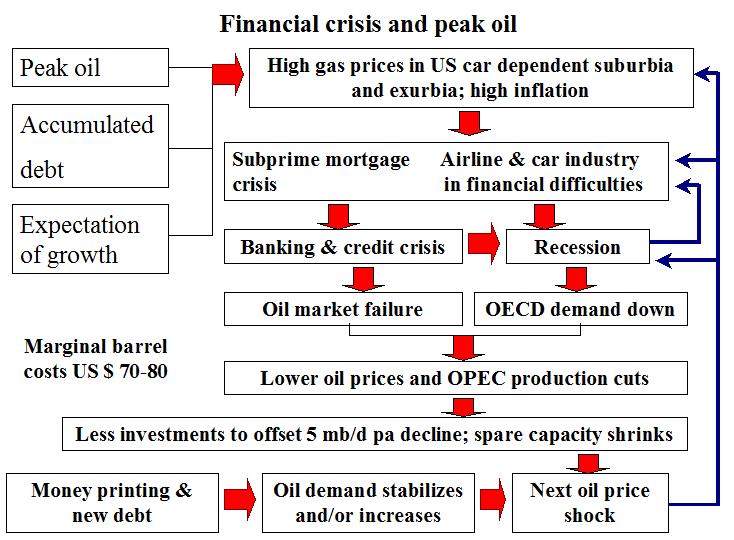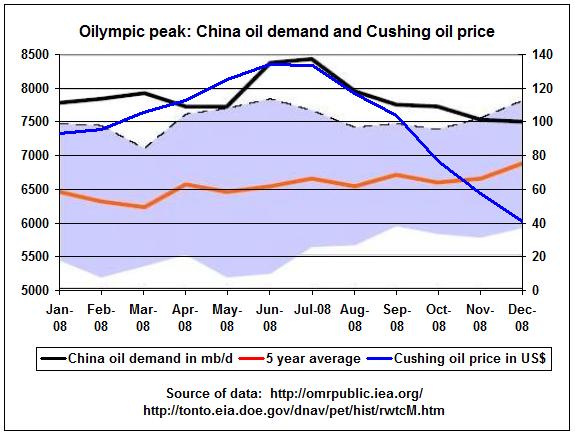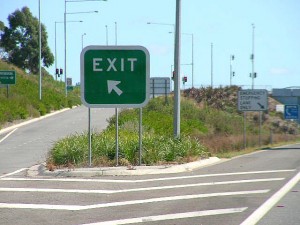In its final report on the M2 widening the RTA claims again that:
“With reference to the M2 Upgrade project, traffic modelling across the Sydney network indicated that the proposed Upgrade would result in a slight net decrease in annual VKT across the Sydney network…… This net decrease in annual VKT leads to an associated decrease in the quantity of fuel consumed by private vehicles……”
http://www.hillsm2upgrade.com.au/files/m2upgradesubmissionsandpreferredprojectreport.pdf
Of course this is counterintuitive. After all, Transurban speculates that increasing traffic will bring more toll revenue and increase the value of its shares so that it is easier to raise more capital to build and/or widen yet more tollways. This graph is from a November 2009 presentation at the Deutsche Bank Transport Conference:
http://www.transurban.com.au/files/deutsche.pdf
The slide shows 3 areas of traffic growth for the M2:
(1) widening uplift: 6,000 new traffic
(2) Windsor Rd ramp: 7,000 traffic from other roads diverted to M2
(3) Herring Rd ramp: 5,500 traffic from other roads diverted to M2
Total traffic on the M2 was 97,000 ADT in the September 2010 quarter
http://www.transurban.com.au/files/September_traffic_and_revenue_data.pdf
Let’s do some simple number crunching and assume that indeed (2) and (3) is diverted traffic. Total traffic now is therefore 97,000 per day on the M2 and 7,000 + 5,500 using other roads in the same corridor = 109,500.
(1) The widening uplift will bring an increase of (109,5000 + 6,000)/109,500 => +5.5 % increase in fuel consumption
Most of this increase is likely to be from induced traffic growth as described in research done by Michelle Zeibots at the Institute for Sustainable Futures
http://datasearch.uts.edu.au/isf/staff/details.cfm?StaffId=2344
Potential fuel savings
Transurban runs this website
http://www.mycommute.com.au/home.htm
in which one can calculate fuel savings by using the M2 compared to other alternative roads. On the Old Windsor Rd to North Ryde trip the savings are estimated at 0.67 litres per 100 km.
A recent study by the Prime Minister’s energy efficiency task group showed that the average fuel consumption of new cars is around 10 litres/100 km (see graph in previous post http://www.crudeoilpeak.com/?p=2012 ). The actual average consumption of the whole car fleet is worse than that so if we calculate a saving of 0.67 litres / 10 litres = 6.7% this figure would be on the high side.
Assuming – as claimed by the RTA – that the traffic on the new ramps is existing traffic from other roads, but diverted to the M2, we get following savings:
(1) Windsor Rd ramp 7,000//109,500 * 6.7% = 6.4% * 6.7% = 0.43%
(2) Herring Rd ramp 5,500/109,500 * 6.7% = 5% * 6.7 % = 0.34 %
This calculation shows that the savings of 0.43 % + 0.34 % = 0.77 % are just a fraction of the additional consumption of 5.5% from new traffic.
Mycommute also contains fuel savings of 1.15 ltrs. / 100 km from another typical trip, between Parklea and Circular Quay
Using this increased saving for the longer trip we get 1.32 % saving against 5.5% increase from new traffic.
In case the traffic on the new ramps is also at least partially induced, new traffic, the savings would of course be lower still.
Conclusion: the RTA will use any argument to push its case for more toll-ways, a strategy which will definitely increase Sydney’s oil dependency and therefore vulnerability.
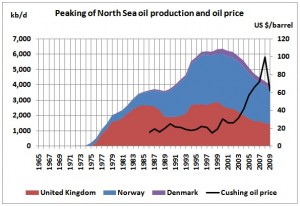 This is bad policy as we have now 6 years of peak oil experience, with a prelude of 3 years
This is bad policy as we have now 6 years of peak oil experience, with a prelude of 3 years
1. The North Sea oil production started its irreversible decline in 2001/2002. That gave OPEC the upper hand and oil prices went out of the 20-30 dollar band in the coming year.
North Sea oil production (data from BP statistical review) and cushing oil price (EIA data) >>>
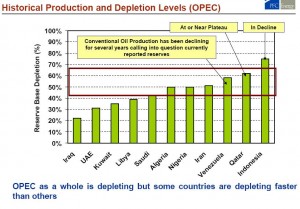 2. The Iraq invasion in 2003 was not just about oil, it was about peak oil. Iraq was the only country in the ME which had historically under-produced in the 80s and 90s. It was known from Simmon’s giant oil field study that Saudi Arabia was at or near their peak. The prize was Iraq’s pre-peak oil (1st column in this graph >>>), the objective to push the global peak a couple of years into the future. This backfired and Iraq’s future oil production is now uncertain.
2. The Iraq invasion in 2003 was not just about oil, it was about peak oil. Iraq was the only country in the ME which had historically under-produced in the 80s and 90s. It was known from Simmon’s giant oil field study that Saudi Arabia was at or near their peak. The prize was Iraq’s pre-peak oil (1st column in this graph >>>), the objective to push the global peak a couple of years into the future. This backfired and Iraq’s future oil production is now uncertain.
Right: OPEC oil depletion graph from the PFC Energy presentation in Sept 2004 at the Centre for Strategic and International Studies
http://www.ecolo.org/documents/documents_in_english/oil-forecasts-04.pdf
3. The global crude peak started in 2005. The GFC was triggered by the convergence of high oil prices and accumulated debt (itself increased by oil prices >$30).
4. Saudi Aramco’s oil exports also peaked in 2005. http://www.crudeoilpeak.com/?p=1738
5. Iran’s oil exports may shrink to half by 2015 which means Iran needs an oil price of $130 to balance their budget.
6. Using decline rates in existing, maturing fields and looking at new projects it can be calculated that the next oil crunch will be around 2012, just when the M2 widening is expected to be completed. Toll increases will not be implementable at that time. http://www.crudeoilpeak.com/?p=1971 This estimate comes from Chris Skrebowski, (former editor of Petroleum Review and now with the UK based Energy Institute), who did a presentation to CEDA in Sydney and Melbourne in 2006. A year before, Chris correctly predicted a crunch after 2008, which was brought forward by an extra 800 kb/d of demand from China for the Olympic Games (Oilympic peak in July 2008), the cause for $147 oil.
7. 80% of Australia’s fuels are derived from either importing crude or fuels directly. Click on “Australian graphs” on the menu of this site. Our oil exports consist mainly of light oil much of which at present cannot economically be used in our own refineries. See API report
http://www.aip.com.au/pdf/AIP%20Paper%20-%20Maintaining%20Supply%20Reliability.pdf
8. Global oil export volumes available for oil importing countries outside Chindia will shrink by 1/3rd by 2015. http://www.crudeoilpeak.com/?p=1934
Therefore, Australia will slide into a number 1 oil import crisis already in the next years as our own oil production is also declining. http://www.crudeoilpeak.com/?p=1843
The Federal Resource Minister has acknowledged the oil import problem in an interview with Kerry O’Brien on the ABC 7.30 report on 21/2/2008 but has kept quiet since then
http://www.abc.net.au/7.30/content/2007/s2169087.htm
There is nothing which can replace crude oil as a primary energy source to drive cars. LPG is also imported on the East Coast. The conversion capacity for compressed natural gas is 150,000 vehicles pa, a drop in the ocean of 12 million cars. We are also exporting all our gas instead of using it as transport fuel. And we don’t even have enough licensed gas mechanics. In the best case scenario, only 20% of cars could be “green” cars by 2020.
http://www.crudeoilpeak.com/?p=1631
Therefore, given the enormous inertia in the existing petrol based car fleet, there will be no smooth transition to any other car fleet, even EVs, because it is basically too late and the carbon free energy isn’t there. High petrol prices, car pooling and later fuel rationing are already pre-programmed. Population growth will make things worse as petrol lines at filling stations will be longer.
This is an excerpt from Jeff Rubin’s lecture at the ASPO 2010 conference, now available as a transcript on the oildrum:
I will tell you where I think oil prices are going. Even in this most anemic of economic recoveries, we are going to see triple digit oil prices. We are not going to see triple digit oil prices in 10 to 15 years. And it is certainly not clear to me that the global economy is better able to handle that than in 2008. Now, a lot of people will say, “Jeff, economic history tells us that scarcity is the mother of invention. Give us 10 to 15 years of adjustment, and we will develop alternate technology, so we won’t be carbon-dependent.”
And they are right. Give us 10 to 15 years, and we will solve this on the supply side. But as I say, our rendezvous with triple digit oil prices is not in 10 or 15 years; it is in 10 or 15 months. So instead of trying to turn cow-shit into high octane fuel, we are going to have to learn to get off the road, and that is just what happened. In 2009, there were 4 million fewer cars on the road than there were the year before. In the next ten years, 40 million North Americans will be taking the exit lanes. The question is, “Will there be a bus to get on?” Instead of giving $40 billon to General Motors, what we should have done is spend $40 billion on public transit, so there would be a bus to get on.In a world of triple digit oil prices, all of the sudden the economy’s speed limit changes. And that is one of the problems that we have here in America, is that we don’t recognize that our economy’s speed limit has changed. What the economy could grow at when oil was $20 to $30 barrel is a whole different speed limit than what the US economy can grow at when oil is $80 to $150 barrel.
http://www.theoildrum.com/node/7095?nocomments
The question is: when will Sydney’s motorists have to take the exit lane?
http://www.hobbiesplus.com.au/signspotters/fwy110405%20019.jpg
As oil declines, we have to increase the productivity of using oil in the economy. The above example shows that toll-ways can’t achieve that. It has to be energy efficient rail. The new business model for Transurban would have to be Transperth.
